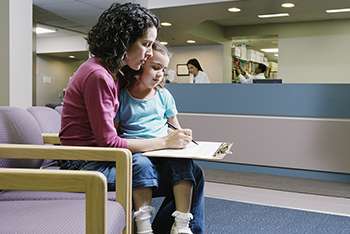Checking Into Surgery

Our team will do everything we can to keep your child comfortable before, during and after surgery. We will also keep you and your family informed of everything happening the day of surgery. Get directions to surgery locations
Checking In For Surgery
Once you arrive at your surgery location, you and your child will head to the Admissions Office.
- At Ronald Reagan UCLA Medical Center, the Admissions Office is located on the first floor of the hospital. Find maps and directions.
- At UCLA Santa Monica Medical Center, the Admissions Office is located on the first floor of the hospital in room G314. Find maps and directions.
- For the Ambulatory Surgery Center, you and your family will come to the check-in desk at the scheduled outpatient surgery location. Find maps and directions to the Westwood location and the Santa Monica location.
After you check in, you and your child will wait in the surgical waiting area. When it is your child’s turn, an escort will take you to check into the Pretreatment Unit (PTU). This is where you and your child will stay in preparation for surgery.
Pre-Surgery: What to Expect
What happens in the PTU:
- Changing clothes: You and your child will enter a private exam room where your child will change into a hospital gown. Please keep your child’s clothes with you for after surgery.
- Health check: Your child’s nurse will assess your child’s health status, take your child’s vital signs, ask about your child’s current medications, and ask about the last time he/she ate or drank.
- Meet the team: You will meet the members of your child’s surgical and anesthesia team. Feel free to ask the surgeon any questions you may still have about the surgery. You will have a chance to review the anesthesia plan. Find out what to know about anesthesia.
- Child Life Specialist: For procedures and surgeries in the main hospital, a Child Life Specialist is usually available. They help children cope with hospitalization, often using play, and are experts at explaining what is happening in child-friendly terms: “There will be a lot of bright lights and equipment, and the doctors and nurses will be wearing masks and long gowns.”
- Sedation: The anesthesiologist may give your child a sedative or relaxing medicine. This can make the child act silly and become sleepy. After taking it, your child should remain sitting in the hospital bed.
- Waiting: You will stay with your child while he/she is waiting to go to the operating room (OR).
During Your Child’s Surgery: What to Expect
When it is time for your child to go to the operating room, here is what you can expect:
- Transfer: One of our team members will bring your child to the OR. Parents usually do not accompany their child into the OR. However, in certain situations, parents may be allowed into the OR with their child. Your team will discuss this with you. The Child Life Specialist can also help with transferring your child from the PTU to the operating room. This is particularly helpful for special needs children.
- In the OR: Your child will receive anesthesia. The Child Life Specialist is available to stay in the OR while your child receives anesthesia, if this is part of the plan that you and the team create. Learn what you need to know about anesthesia.
- Waiting room: Once your child leaves for the OR, you will gather your belongings, and the staff will direct you where to wait during your child's surgery. All family members and friends who accompany you and your child on the day of surgery should wait in this area.
- Staying on-site: A parent or legal guardian must be on-site with your child throughout the day of surgery. We ask that you not leave the hospital/surgery center during your child's stay, even during the surgery.
- After the surgery: We will let you know as soon as your child’s surgery is complete. Someone from the surgery team will tell you how the surgery went and answer your questions.
- Seeing your child: We make every effort to reunite you with your child as soon as possible after routine surgery in the post-anesthesia care unit (PACU) recovery area. If your child is taken to an intensive care unit (ICU) after major surgery, we will give you instructions on how to get there.
What to Read Next
Read about what to expect after your child’s surgery.